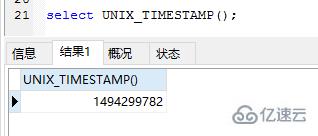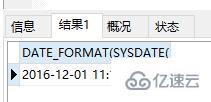What are the date and time types and formatting methods in MySQL

[1] Date and time types in MySQL
In MySQL, date, datetime, time, year and timestamp are commonly used time types
| Data type | Occupied bytes | Minimum value | Maximum value | A zero value represents |
|---|---|---|---|---|
| date | 4 | 1000-01-01 | 9999-12-31 | 0000-00-00 |
| datetime | 8 | 1000-01-01 00:00:00 | 9999-12 -31 23:59:59 | 0000-00-00 00:00: 00 |
| timestamp | 4 | 19700101080001 | Sometime in 2038 | 0000000000000000 |
| time | 3 | -838:59: 59 | 838:59:59 | 00:00:00 |
| year | 1 | 1901 | 2155 | 0000 |
Detailed explanation
##datetime
: Time date type, the format is YYYY-mm-dd HH:ii:ss , the representation range is from 1000 to 9999. But there is a zero value, 0000-00-00 00:00:00;date
: Date is the date part of datetime;time
: time (segment), between a specified interval, from - time to time (represented by negative time);timestamp
: Timestamp, not a conventional timestamp (such as: 14253685), the range is '1970-01-01 00:00:00' to 2037. The format is YYYY-mm-dd HH:ii:ss,The format is completely consistent with datetime;year
:yy and yyyy,yyyy The range of is 1901-2155, and the range of yy is 1970-2069.
create table my_date(
d1 datetime,
d2 date,
d3 time,
d4 timestamp,
d5 year
)charset utf8;
desc my_date
Copy after login
As shown in the figure below: year defaults to 4 digits, that is, YYYY; timestamp cannot be empty, and there is The default value is to refresh this data column when creating new records and modifying existing records. create table my_date( d1 datetime, d2 date, d3 time, d4 timestamp, d5 year )charset utf8; desc my_date

insert into my_date VALUES('2015-09-28 11:50:36','2015-09-28','11:50:54','2015-09-28 11:51:08','2015'); insert into my_date VALUES('2015-09-28 11:50:36','2015-09-28','-11:50:54','2015-09-28 11:51:08','2015');-- -11 insert into my_date VALUES('2015-09-28 11:50:36','2015-09-28','-211:50:54','2015-09-28 11:51:08','2015');-- -2 11 insert into my_date VALUES('2015-09-28 11:50:36','2015-09-28','-2 11:50:54','2015-09-28 11:51:08','2015');-- -2过去两天 #year用69标识-2069 insert into my_date VALUES('2015-09-28 11:50:36','2015-09-28','11:50:54','2015-09-28 11:51:08','69');-- 69 #year用70标识-1970 insert into my_date VALUES('2015-09-28 11:50:36','2015-09-28','11:50:54','2015-09-28 11:51:08','70');-- 70


update my_date set d1 = SYSDATE() where d5=69; select * from my_date

select UNIX_TIMESTAMP();

Test Example
4.1 Query the current time
SELECT SYSDATE() from dual;

4.2 Insert the current time into the above types of columns
insert INTO `user` (name,number,date,datetime,timestamp,time,year) VALUES ( 'Loum',3,SYSDATE(),SYSDATE(),SYSDATE(),SYSDATE(),2016 );

4.3 The length bit of datetime type in mysql The number
is as follows. Usually the length of the datetime type in our MySQL is designed to be 0 by default:`work_time` datetime(0) DEFAULT NULL COMMENT '清收时间',
`work_time` datetime(2) DEFAULT NULL COMMENT '清收时间', # datetime(n)中的n最大值为6 `work_time` datetime(6) DEFAULT NULL COMMENT '清收时间',
2020-08-29 12:52:16.01You will find that there is a decimal point at the end and the numbers after the decimal point will correspond to the corresponding digits - this is called nanoseconds.2020-08-29 12:52:16.014057
The summary is as follows:
date
: only date, no time;datetime
: There is time and date;time
: Only time, accurate to minutes and seconds;timestamp
: timestamp, accurate to minutes and seconds;year
: year, such as 2002, if written is 2002-01-15, calculation will be performed, and the insertion result is 1986
DATE_FORMAT( ) function
You can use the date_format() function to convert time.SELECT DATE_FORMAT(SYSDATE(),'%Y-%m-%d %H:%i:%s') from dual;

date_format( ) 转换格式
| 格式 | 描述 |
|---|---|
| %a | 缩写星期名 |
| %b | 缩写月名 |
| %c | 月,数值 |
| %D | 带有英文前缀的月中的天 |
| %d | 月的天,数值(00-31) |
| %e | 月的天,数值(0-31) |
| %f | 微秒 |
| %H | 小时 (00-23) |
| %h | 小时 (01-12) |
| %I | 小时 (01-12) |
| %i | 分钟,数值(00-59) |
| %j | 年的天 (001-366) |
| %k | 小时 (0-23) |
| %l | 小时 (1-12) |
| %M | 月名 |
| %m | 月,数值(00-12) |
| %p | AM 或 PM |
| %r | 时间,12-小时(hh:mm:ss AM 或 PM) |
| %S | 秒(00-59) |
| %s | 秒(00-59) |
| %T | 时间, 24-小时 (hh:mm:ss) |
| %U | 周 (00-53) 星期日是一周的第一天 |
| %u | 周 (00-53) 星期一是一周的第一天 |
| %V | 周 (01-53) 星期日是一周的第一天,与 %X 使用 |
| %v | 周 (01-53) 星期一是一周的第一天,与 %x 使用 |
| %W | 星期名 |
| %w | 周的天 (0=星期日, 6=星期六) |
| %X | 年,其中的星期日是周的第一天,4 位,与 %V 使用 |
| %x | 年,其中的星期一是周的第一天,4 位,与 %v 使用 |
| %Y | 年,4 位 |
| %y | 年,2 位 |
str_to_date()函数
字符串转换为date:
str_to_date( '2016-12-15 16:48:40', '%Y-%m-%d %H:%i:%S' )
The above is the detailed content of What are the date and time types and formatting methods in MySQL. For more information, please follow other related articles on the PHP Chinese website!

Hot AI Tools

Undresser.AI Undress
AI-powered app for creating realistic nude photos

AI Clothes Remover
Online AI tool for removing clothes from photos.

Undress AI Tool
Undress images for free

Clothoff.io
AI clothes remover

Video Face Swap
Swap faces in any video effortlessly with our completely free AI face swap tool!

Hot Article

Hot Tools

Notepad++7.3.1
Easy-to-use and free code editor

SublimeText3 Chinese version
Chinese version, very easy to use

Zend Studio 13.0.1
Powerful PHP integrated development environment

Dreamweaver CS6
Visual web development tools

SublimeText3 Mac version
God-level code editing software (SublimeText3)

Hot Topics
 MySQL: An Introduction to the World's Most Popular Database
Apr 12, 2025 am 12:18 AM
MySQL: An Introduction to the World's Most Popular Database
Apr 12, 2025 am 12:18 AM
MySQL is an open source relational database management system, mainly used to store and retrieve data quickly and reliably. Its working principle includes client requests, query resolution, execution of queries and return results. Examples of usage include creating tables, inserting and querying data, and advanced features such as JOIN operations. Common errors involve SQL syntax, data types, and permissions, and optimization suggestions include the use of indexes, optimized queries, and partitioning of tables.
 MySQL's Place: Databases and Programming
Apr 13, 2025 am 12:18 AM
MySQL's Place: Databases and Programming
Apr 13, 2025 am 12:18 AM
MySQL's position in databases and programming is very important. It is an open source relational database management system that is widely used in various application scenarios. 1) MySQL provides efficient data storage, organization and retrieval functions, supporting Web, mobile and enterprise-level systems. 2) It uses a client-server architecture, supports multiple storage engines and index optimization. 3) Basic usages include creating tables and inserting data, and advanced usages involve multi-table JOINs and complex queries. 4) Frequently asked questions such as SQL syntax errors and performance issues can be debugged through the EXPLAIN command and slow query log. 5) Performance optimization methods include rational use of indexes, optimized query and use of caches. Best practices include using transactions and PreparedStatemen
 How to connect to the database of apache
Apr 13, 2025 pm 01:03 PM
How to connect to the database of apache
Apr 13, 2025 pm 01:03 PM
Apache connects to a database requires the following steps: Install the database driver. Configure the web.xml file to create a connection pool. Create a JDBC data source and specify the connection settings. Use the JDBC API to access the database from Java code, including getting connections, creating statements, binding parameters, executing queries or updates, and processing results.
 Why Use MySQL? Benefits and Advantages
Apr 12, 2025 am 12:17 AM
Why Use MySQL? Benefits and Advantages
Apr 12, 2025 am 12:17 AM
MySQL is chosen for its performance, reliability, ease of use, and community support. 1.MySQL provides efficient data storage and retrieval functions, supporting multiple data types and advanced query operations. 2. Adopt client-server architecture and multiple storage engines to support transaction and query optimization. 3. Easy to use, supports a variety of operating systems and programming languages. 4. Have strong community support and provide rich resources and solutions.
 How to start mysql by docker
Apr 15, 2025 pm 12:09 PM
How to start mysql by docker
Apr 15, 2025 pm 12:09 PM
The process of starting MySQL in Docker consists of the following steps: Pull the MySQL image to create and start the container, set the root user password, and map the port verification connection Create the database and the user grants all permissions to the database
 MySQL's Role: Databases in Web Applications
Apr 17, 2025 am 12:23 AM
MySQL's Role: Databases in Web Applications
Apr 17, 2025 am 12:23 AM
The main role of MySQL in web applications is to store and manage data. 1.MySQL efficiently processes user information, product catalogs, transaction records and other data. 2. Through SQL query, developers can extract information from the database to generate dynamic content. 3.MySQL works based on the client-server model to ensure acceptable query speed.
 Laravel Introduction Example
Apr 18, 2025 pm 12:45 PM
Laravel Introduction Example
Apr 18, 2025 pm 12:45 PM
Laravel is a PHP framework for easy building of web applications. It provides a range of powerful features including: Installation: Install the Laravel CLI globally with Composer and create applications in the project directory. Routing: Define the relationship between the URL and the handler in routes/web.php. View: Create a view in resources/views to render the application's interface. Database Integration: Provides out-of-the-box integration with databases such as MySQL and uses migration to create and modify tables. Model and Controller: The model represents the database entity and the controller processes HTTP requests.
 How to install mysql in centos7
Apr 14, 2025 pm 08:30 PM
How to install mysql in centos7
Apr 14, 2025 pm 08:30 PM
The key to installing MySQL elegantly is to add the official MySQL repository. The specific steps are as follows: Download the MySQL official GPG key to prevent phishing attacks. Add MySQL repository file: rpm -Uvh https://dev.mysql.com/get/mysql80-community-release-el7-3.noarch.rpm Update yum repository cache: yum update installation MySQL: yum install mysql-server startup MySQL service: systemctl start mysqld set up booting






